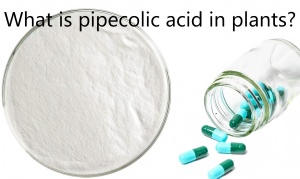What is pipecolic acid in plants?

Pipecolic acid in plants is a small molecule that plays a big role in plant defense. It’s especially important when plants are under attack by pathogens. Think of it as a kind of immune booster that helps plants prepare and respond to stress. This molecule is part of a larger system in plants that controls how they react to harmful microbes. It’s closely tied to salicylic acid, another well-known plant defense hormone. Together, these molecules help plants develop what scientists call systemic acquired resistance, or SAR. This means that when one part of the plant gets infected, the whole plant can get ready to fight off disease. Understanding how pipecolic acid works is important for agriculture and plant biology because it could help make crops more resistant to disease naturally.
Where Pipecolic Acid Comes From
Pipecolic acid is derived from the amino acid lysine. In plant cells, an enzyme called ALD1 (AGD2-LIKE DEFENSE RESPONSE PROTEIN1) helps convert lysine into pipecolic acid. This usually happens when the plant senses a microbial infection. The process takes place in the chloroplasts and is tightly regulated. Plants don’t produce pipecolic acid in large amounts under normal conditions. Instead, production ramps up when the immune system is triggered, especially in response to bacterial or fungal invasion. Once it’s made, pipecolic acid can move through the plant to signal other tissues, preparing them for potential attacks.
Its Role in Plant Immunity
The main role of pipecolic acid in plants is in immune signaling. It works alongside salicylic acid to amplify the plant’s immune response. What makes it special is that it doesn’t just stay at the infection site. Pipecolic acid travels to other parts of the plant, warning them of the incoming threat. It helps turn on defense genes in distant tissues, so if the infection spreads, the plant is better prepared. This ability to create a kind of immune memory is key to systemic acquired resistance. Without pipecolic acid, plants struggle to mount this whole-plant defense system effectively.
Interaction with Salicylic Acid
Pipecolic acid and salicylic acid work in tandem. While salicylic acid is a well-known hormone in plant immunity, pipecolic acid acts as a kind of helper that strengthens and sustains the defense response. Recent studies have shown that pipecolic acid can increase the production of salicylic acid, forming a positive feedback loop. This loop ensures that once a pathogen is detected, the defense response is not only fast but also lasts long enough to prevent further damage. Together, they create a robust network that makes systemic acquired resistance more efficient and reliable.
Why It Matters for Crop Protection
Understanding pipecolic acid is more than just plant biology—it's about practical benefits. If we can find ways to enhance pipecolic acid production in crops, we might boost their natural disease resistance without needing chemical treatments. This could lead to more sustainable farming. Crops that can defend themselves better might need fewer pesticides, lowering costs and environmental impact. Scientists are now exploring genetic engineering and breeding strategies to take advantage of this natural immune system booster. As our understanding of plant immunity grows, pipecolic acid is likely to become a key target for improving agricultural resilience.


